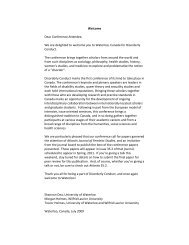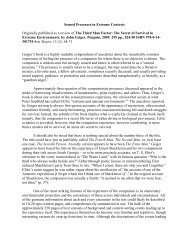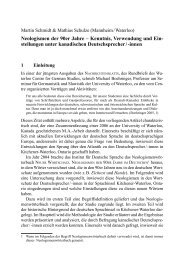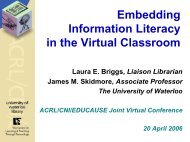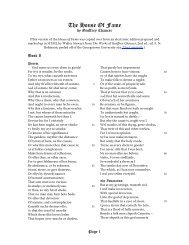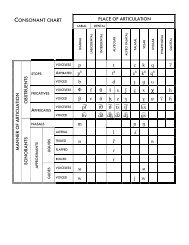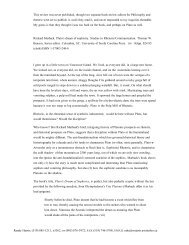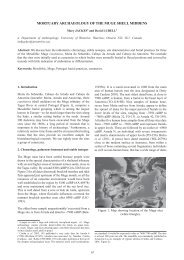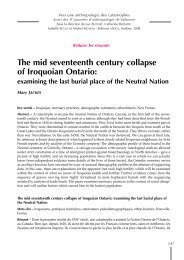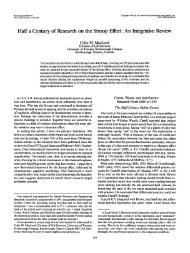Individual Differences in Learning and Memory: A Unitary ...
Individual Differences in Learning and Memory: A Unitary ...
Individual Differences in Learning and Memory: A Unitary ...
You also want an ePaper? Increase the reach of your titles
YUMPU automatically turns print PDFs into web optimized ePapers that Google loves.
DIFFERENCES IN LEARNING AND MEMORY 541<br />
scores. Furthermore, their claims aside, noth<strong>in</strong>g <strong>in</strong> the previous work<br />
leads directly to any predictions concern<strong>in</strong>g picture process<strong>in</strong>g. Thus, the<br />
lack of a relationship between verbal ability <strong>and</strong> picture categoriz<strong>in</strong>g time<br />
st<strong>and</strong>s apart from the earlier f<strong>in</strong>d<strong>in</strong>gs. The lack of a relationship for words<br />
is more puzzl<strong>in</strong>g, but may stem partially from the fact that subjects were<br />
provided with the category name <strong>in</strong> the Hogoboam <strong>and</strong> Pellegr<strong>in</strong>o study<br />
whereas they had to access it from LTS <strong>in</strong> the Goldberg at al. study.<br />
Rather than constitut<strong>in</strong>g a refutation of the conclusion regard<strong>in</strong>g code<br />
access based on the match<strong>in</strong>g studies, the Hogoboam <strong>and</strong> Pellegr<strong>in</strong>o<br />
results provide a theoretical <strong>and</strong> methodological challenge to them. It will<br />
be <strong>in</strong>terest<strong>in</strong>g to see how this is resolved.<br />
Code access is only one aspect of semantic LTS that could be exam-<br />
<strong>in</strong>ed. The structure of semantic space is also a potential source of <strong>in</strong>di-<br />
vidual differences, but there has been little research <strong>in</strong> this area. Apart<br />
from a demonstration by Loftus <strong>and</strong> Loftus (1974) that advanced graduate<br />
students <strong>in</strong> psychology show a superior organization of psychologists <strong>in</strong><br />
various areas to that evidenced by first-year students, I know of none. As<br />
always, separat<strong>in</strong>g structure from process is a complex problem, but this<br />
appears to be one area where the results could be very <strong>in</strong>formative.<br />
Analyses of the type conducted by Smith, Shoben, <strong>and</strong> Rips (1974) should<br />
be considered as a means of <strong>in</strong>vestigat<strong>in</strong>g <strong>in</strong>dividual differences <strong>in</strong> seman-<br />
tic LTS.<br />
CONCLUDING COMMENTS<br />
This brief review has only scratched the surface of the <strong>in</strong>formation<br />
process<strong>in</strong>g approach to <strong>in</strong>dividual differences. For example, I have not<br />
covered the many studies related to developmental trends <strong>in</strong> <strong>in</strong>dividual<br />
differences (e.g., Bisanz, Danner, & Resnick, Note 1; Keat<strong>in</strong>g & Bobbitt,<br />
1978), nor those related to ag<strong>in</strong>g (some of which are reviewed by Eysenck,<br />
1977). Neither have I discussed the work on more complex cognitive tasks<br />
such as read<strong>in</strong>g (e.g., Jackson & McClell<strong>and</strong>, 1979) <strong>and</strong> comprehen-<br />
sion (e.g., Perfetti & Lesgold, 1978). Instead, I have restricted my atten-<br />
tion solely to basic processes with<strong>in</strong> the framework of the two-state<br />
model.<br />
The field is <strong>in</strong> a period of rapid growth which I believe will cont<strong>in</strong>ue <strong>and</strong><br />
escalate. Hopefully, one of the directions taken will be to systematize<br />
some of the discrepant f<strong>in</strong>d<strong>in</strong>gs reported here. Hopefully, too, the organi-<br />
zation provided by <strong>in</strong>formation process<strong>in</strong>g models will be a guid<strong>in</strong>g force<br />
<strong>in</strong> this growth. It seems quite possible that one of the reasons for the<br />
uneven history of the field has been the lack of structure, the tendency to<br />
study <strong>in</strong>dividual differences <strong>in</strong> a haphazard fashion without benefit of<br />
theory. More consideration will have to be given to the higher-order<br />
theoretical issues (cf. Carroll, 1978; Hunt & MacLeod, 1978) as well as to<br />
the more specific ones.



